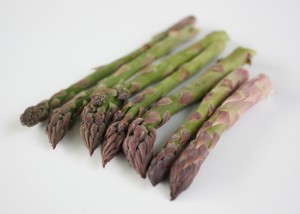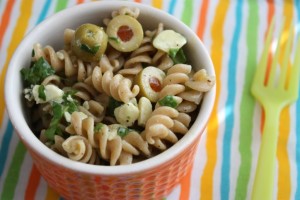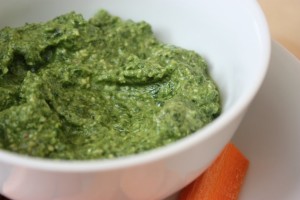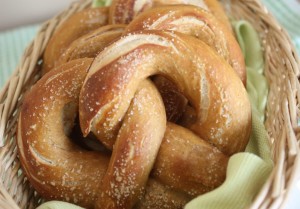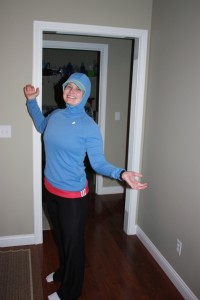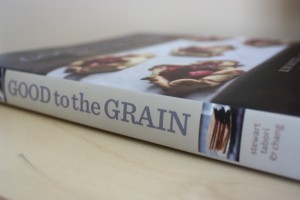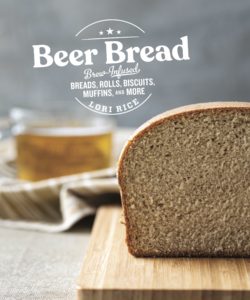Quick Side Dishes and Chimichurri Beer Burgers
April 13, 2010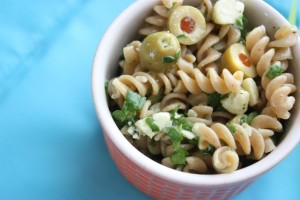
½ cup fresh spinach, finely chopped, firmly packed
15 pimento stuffed green olives, halved
1 – 2 oz Gorgonzola cheese, crumbled
2 tbsp olive oil
3 cups dry, whole wheat pasta, cooked and rinsed to cool
Black pepper to taste
In a medium-sized bowl combine the spinach, olives, cheese and olive oil. Stir to break up the cheese so it is evenly distributed.
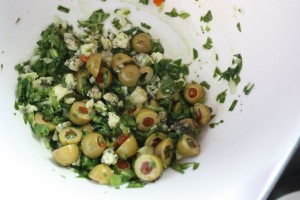
Add the drained pasta to bowl and toss to coat. Sprinkle with black pepper. You can add salt too if you wish, but I found the olives and cheese added enough salty flavor for my tastes. Serves 4.
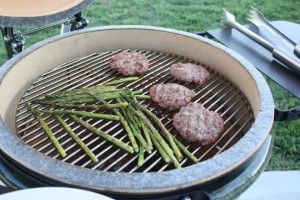
1 lb grass-fed beef
¼ cup beer (I used a light ale)
¼ cup panko bread crumbs
1 tsp chimichurri seasoning mix
½ tsp sea salt
¼ tsp black pepper
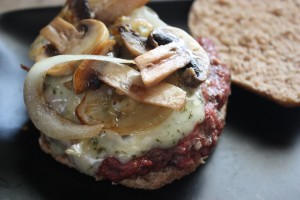
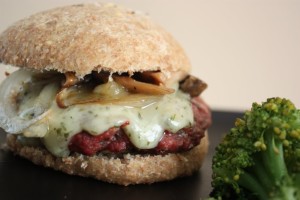
I’m submitting the pasta salad to the April Side Dish Showdown at Cinnamon Spice & Everything Nice.
A Boy, His Grill, and a Spatchcocked Chicken
April 12, 2010Over the past few months I’ve regularly documented all of the things I am thrilled to have returned to since our move back to the States. In fact, I wouldn’t blame you for thinking me annoying because I tend to express my excitement with an over abundance of irritating happiness.
There was the real winter with snow which necessitated the wearing of boots not just for fashion, but for functionality. A full size oven with a temperature setting that goes low enough to prevent burning all my baked goods to a crisp. A washer and dryer that take fewer than 90 minutes for each cycle. My KitchenAid mixer with all its powerful capabilities.
Ahhh, I smile just thinking about it all.
Despite my glowing excitement, I was getting a little bit worried that my husband hadn’t yet experienced such bliss. Sure, he had some of his favorite electronics back, and we now have a nice size garage with a yard to tend to, but something was missing.
Over Easter weekend I learned what it was. This:
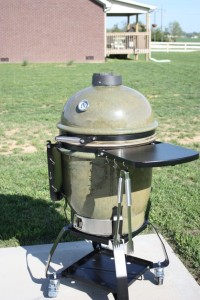
Yes, a grill. As much as we enjoyed the food and culture of the Brazilian barbeque, let’s just say, there is no place like home. We talked about it often during our time abroad — grilling different kinds of meats from chicken to pork tenderloin, burgers, hot dogs and even fruits and vegetables; the array of side dishes, and sitting outside all afternoon with a beer in hand.
He had his heart set on a Big Green Egg for a long time, even before we moved back to the US. However, after some research he learned that there are the same style of grills out there (a ceramic pod grill that cooks by charcoal) without the same price tag.
We couldn’t find any sources around here, but some stores in our hometown occasionally carried them. When he learned that two had come in the day we got to Indiana for our Easter visit, off he went with my Dad to grab one before it was gone.
He’s been anxiously awaiting the opportunity to get cooking so this weekend we decided to break out the new grill and see what this baby can do.
First we tried chicken. Until this weekend I had seen the process of spatchcocking a chicken on the web and on tv, but had no idea that “spatchcocking” was the appropriate term. I gave it a try last night. To be honest, I did get a flat chicken out of the process which was the goal, but I really have no idea if I did it exactly as it should be done. In fact, I already discovered a step I accidentally skipped. Shhhh! I’m not telling.
Therefore, you really shouldn’t listen to me about how to spatchcock a chicken when there are much more knowledgeable people out there to tell you. Check out A Good Appetite or this YouTube video for some help.
I can, however, tell you the rub I used on the bird which turned out nicely. My husband wanted something a little more spicy/Cajun in nature since I typically do Italian-style herb rubs. I coated the chicken with the spices below and then rubbed it generously with olive oil.
First Chicken of the Season Spicy Rub
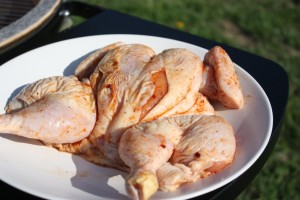 1 tsp chili powder
1 tsp chili powder
1 tsp cumin
¼ tsp crushed red pepper
1 tsp garlic powder
1 ½ tsp sea salt
¾ tsp ground black pepper
Combine in a small dish and mix with your fingers to crust of the red pepper with the other spices. Rub over the chicken including under the skin.
After an hour on the grill, the chicken was perfect. Nice and juice with a crispy skin just as was predicted by all the recipes I’d read prior to our attempt. There will be lots of grilled chicken in our near future, especially once Pike Valley has some available again later in the month. They should process 32,000 chickens this year. Not bad for a farm using humane, sustainable practices. The word is really getting out about them.
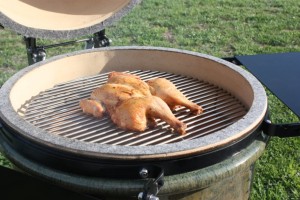
In addition to the chicken we decided to grill up some burgers for later in the week, as well as some asparagus as a side for our chicken. Grilled asparagus is about the easiest thing you can cook on a grill. I drizzled it with olive oil and sprinkled on some of the herb seasoning I told you about a few days ago. About five to eight minutes on the grill and it’s all done.
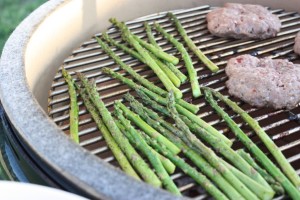
Tomorrow I’ll tell you more about the burgers and a new pasta salad I tried out.
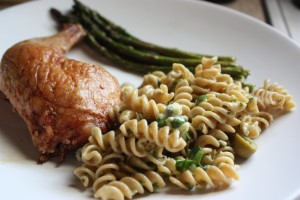
Have the grill out yet? What’s on the menu?
Links to a Healthy Weekend
April 10, 2010On Twitter the other day I wrote that I’m feeling a bit overwhelmed. Anyone else in that boat? This isn’t necessarily a negative thing, but all my thoughts and actions have drifted outdoors. I’m loving the weather and our new yard, however, between the half marathon, lawn mowing, prepping a garden and making our way through the final boxes still left in the garage there is always something to do. Computer time is work time and if I’m not working, I want to be outside.
Spinach Pesto Spread
April 9, 2010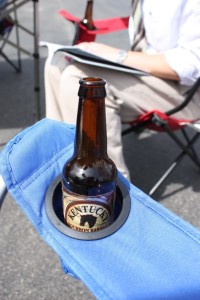
This is why I love it. Football tailgates with their barbeque and chips are lots of fun, but going to Keeneland gives you the chance to be a little more creative and fancy with your food choices.
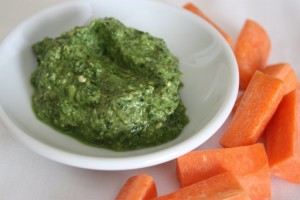
The spinach had been purchased, however, so I decided to replace the basil in my typically pesto recipe with the spinach. It turned out great! I added enough oil to make it a spread. I ended up liking it more as it sat in the fridge a couple days because the walnuts and spinach combined into a creamy paste that was perfect for dipping carrots or pretzels.
2 cloves garlic
¼ cup chopped walnuts
3 tbsp parmesan cheese, grated
Olive oil
Salt and pepper to taste

Salmon-Stuffed Portabella Mushrooms
April 5, 2010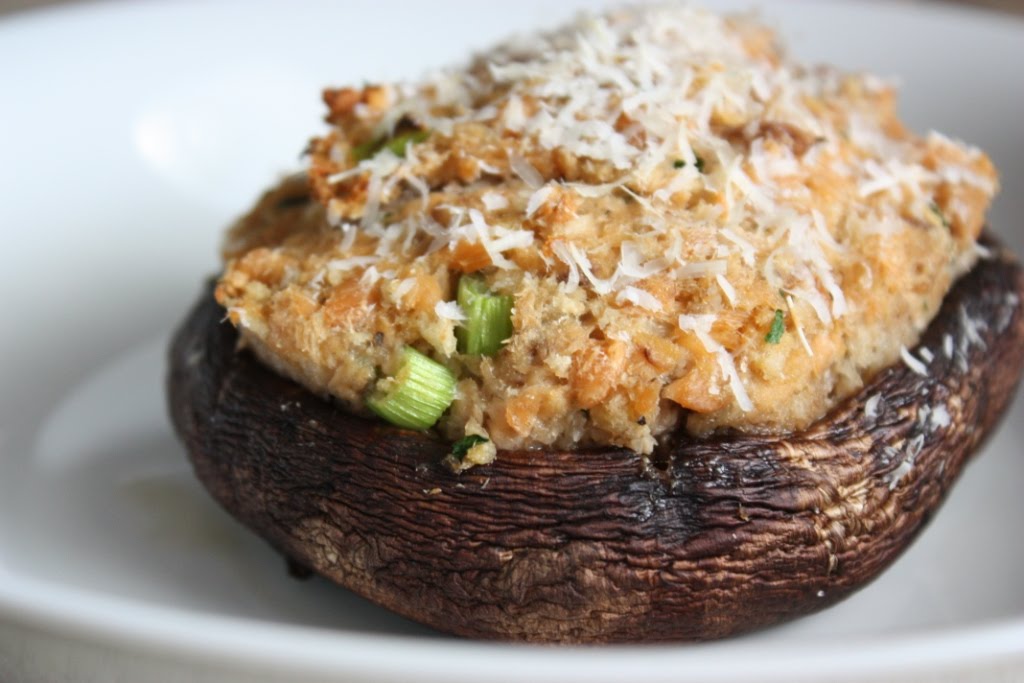
Over the past year or so we have progressively been eating fewer and fewer foods from cans. A positive, healthy move for us, but there are still a few things I grab when I zip down the canned food aisle. One of these is salmon.
Growing up I loved salmon patties which my mom always made from canned salmon. It seems kind of strange now because I don’t really see many kids excited about canned salmon. I think I mostly enjoyed eating the bones as they went from crunchy to magically disappearing altogether in my mouth. As I got older and began studying nutrition it just happened to be a bonus that these little bones are a source of calcium.
It had been a very long time since I’d even thought about salmon patties, but recently I decided to make up a batch. Of course, I was trying to find a way to give them a twist. It seems I rarely cook at all anymore without trying to give things a twist.
I don’t often by portabella mushroom caps, but had branched out and picked up a pack on a trip to the market a few days before. After a little quiet thought in the kitchen I could have sworn I heard them begging to be stuffed with salmon.
So I made up a batch of salmon patty mix, batter, dough – what the heck do you call it prior to being cooked anyway? I formed the nameless concoction into a nice mound inside a mushroom cap coated in olive oil and sprinkled on some parmesan cheese.
After about 25 minutes in the oven, I was greeted with a tender mushroom filled with soft salmon and a slightly browned and crispy edge. A definite winner and a nice change from the same ol’ patty.
This recipe makes enough for four stuffed mushrooms. I only had two portabellas so I just made two salmon patties for lunch later in the week. They are easy to cook, just form them into flat patties, heat some oil in a pan and cook for about three minutes on each side.
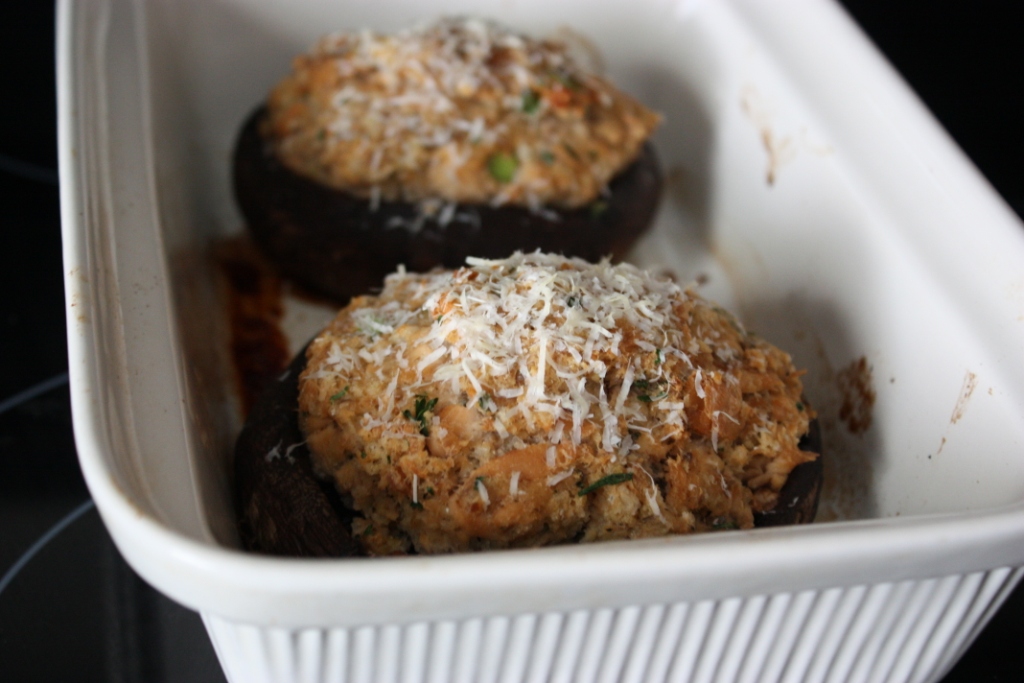
Salmon-Stuffed Portabella Mushrooms
Makes 4 servings
1 can salmon, drained
½ cup panko bread crumbs
1 egg, lightly beaten
½ tsp salt
¼ tsp pepper
¼ tsp garlic powder
1 tsp dried parsley
2 green onions, sliced, greens and some of the white
2 tbsp fresh grated parmesan cheese plus extra for sprinkling
4 portabella mushroom caps
Olive oil
Preheat oven to 400 degrees F. In a bowl combine the salmon, bread crumbs, egg, seasonings, onion and 2 tbsp cheese. Mix well until all ingredients are combined. Place mushroom caps in a baking dish that has been coated with olive oil. Rub more olive oil on the mushrooms, coating them well. Turn the caps top (smooth side) down.
Divide the salmon mixture into four equal parts, form into a ball and mound inside the mushroom cap. Sprinkle with parmesan cheese. Bake for 25 to 35 minutes or until the mushrooms are tender and the cheese has browned a little. Serve warm.
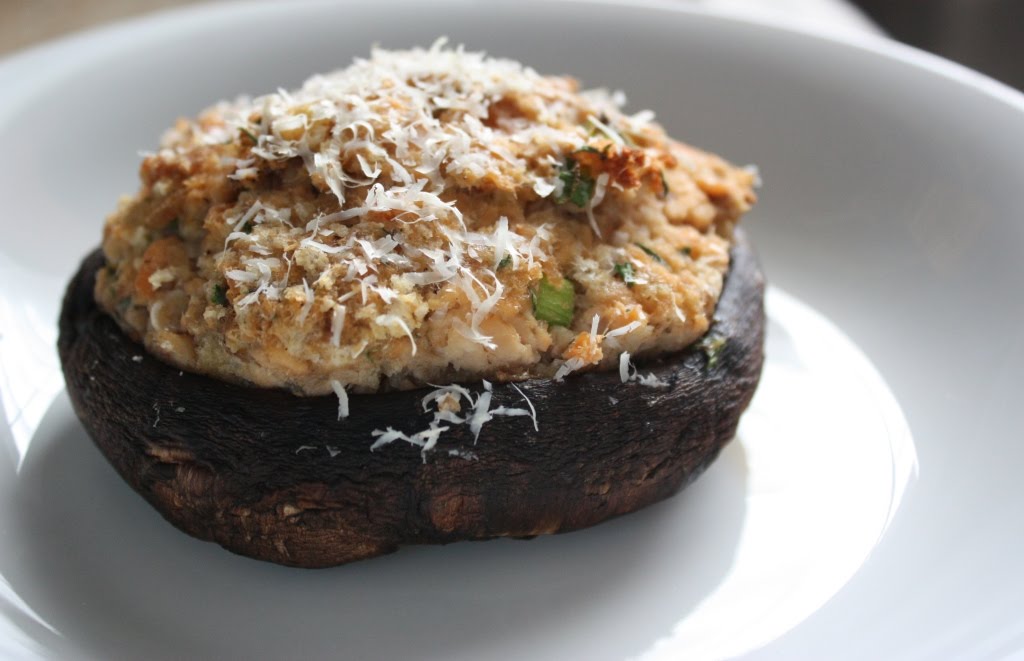
Thanks for reading! All images and content are the property of Fake Food Free unless otherwise stated. Please do not republish recipes and images without written permission. Feel free to Pin images and share links to my posts, but please do not copy and paste recipes or photos and share them on other sites. Confused about copyright and food blogs? Here is some helpful information on Recipe Attribution.
March in Food
April 1, 2010I’m finding that I look forward to the first day of the month so that I can post my Project 365 food recap. It’s been fun to look back each month, and I really think that it is keeping me on my toes with trying new recipes and getting creative. I mean, everyone doesn’t want to see the same photo every day!
I’m thrilled that it is April and we are experiencing true spring weather around here. We will likely hit 80 the end of the week. It will be interesting to see how my food pictures change as more and more fresh produce becomes available.
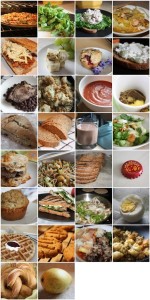
Papa Murphy’s Gourmet Veggie Pizza & the first official meal in our new house!
Lettuce to increase the veggie intake
Tuna salad on whole grain bread
A mediocre soba noodle experiment
Bourbon BBQ sandwiches with mustard coleslaw
Kenny’s Farmhouse Tomato Basil Cheese
7-Grain Blackberry Pecan Muffins
Benedictine salad (cucumber cream cheese salad)
Pastured Pork Chops and Black Beans
Nutty Cauliflower Quinoa
Tomato Basil Soup from A Good Appetite
Braised Lamb over Polenta
Blueberry scone
Whole Wheat Bread from Healthy Bread in Five Minutes a Day
Blackberry, kale smoothie
Shrimp salad with soy dressing
Apple Cheddar Brown Biscuits
Ginger veggies over noodles
Flax bread from Great Harvest
New Belgium beer
Pear Walnut Muffin
Grilled Vegetable Sandwich
Veggie fixin’s for tacos
Success with hard boiled eggs (no green edge!)
Honey Amaranth Waffles
Whole Grain Peanut Butter Cookies
Post-race Spanish Omelet from Alfalfa’s
Curried Lentils with Cauliflower and Sweet Potato
Whole Wheat Soft Pretzels
Champagne Mango
PS. Sorry the mosaic is turning out so small. I’m working on it.
Pretzels: A Word About Easter History
March 30, 20101 ½ cups warm water
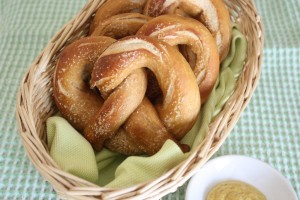
1 tbsp of mascavo/muscavado sugar
1 tsp sea salt
1 pk active dry yeast (I used rapid rise)
4 cups white whole wheat flour
4 tbsp unsalted butter, melted
10 cups water
2/3 cup baking soda
1 egg yolk, beaten
1 tbsp water
Olive oil
Salt or other seasoning
Eating these lovely treats is a far cry from a sacrifice, which is what I usually associate with the Lenten season. So that is why I think I’ll stick with the name “pretiola.” I will gladly take these as a little reward any time of year.
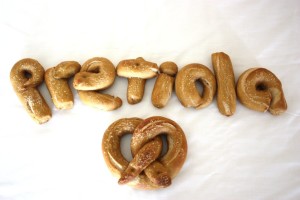
Resources for more info about pretzel history:
Catholic Education Resource Center: Lenten Pretzels
CatholicCulture.org: Pretzels for God
The History of the Pretzel
Snyder’s of Hanover: History of Pretzels
Myths and Truths: My First Half Marathon
March 29, 2010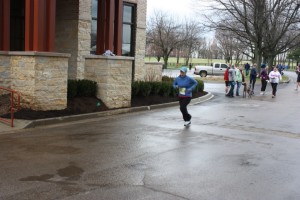
The adrenaline and atmosphere will push you through the last few miles. Myth.
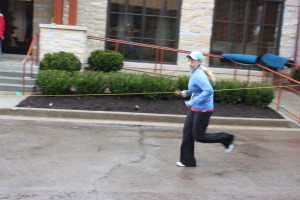
After all this, am I glad I did it? Of course! I accomplished something that I honestly didn’t think I would ever be able to. I also fully believe that pushing myself this hard was beneficial to my well being. I think it is important to find things that push you as hard physically, but it doesn’t have to be running.

Now for all those who have been holding out for the food. We had an amazing post-race brunch at Alfalfa Restaurant in downtown Lexington, KY. I’ve posted about this place before and we certainly weren’t disappointed on this visit. I enjoyed a Spanish Omelet with white cheddar and ranchero sauce with their special Alfafries. My husband had the Breakfast Burritos. We split the Buttermilk Buckwheat Blueberry Pancake. This thing is amazing. The first bite tastes like a blueberry cake donut!
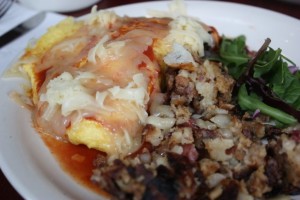
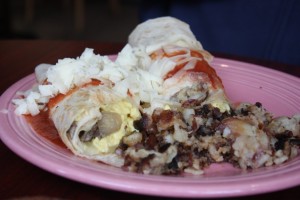
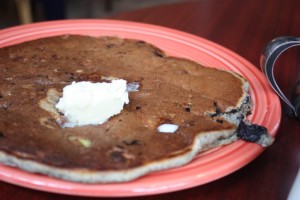
Special congrats to my husband! Although he’s run relays of the same or greater difficulty, this was his first official half marathon finish as well. He finished in 1:53 and is preparing for the Flying Pig Marathon in May.
Good to the Grain: Honey Amaranth Waffles
March 26, 2010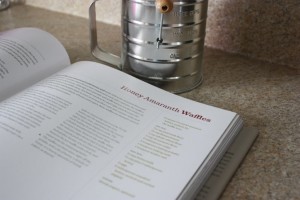
The author, Kim Boyce, was a pastry chef at the well known Spago and Campanile restaurants before she left to raise her kids, and then embark on creating whole grain baked goods for her family to enjoy. The book is filled to brim with 75 recipes of cookies, cakes, waffles, pancakes, breads and tarts made with 12 different whole grain flours.
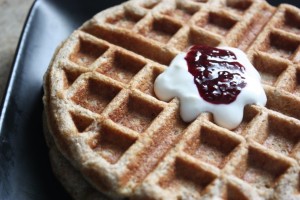
The result? Seriously the best waffles I have yet to make. They were as light and fluffy as any standard white waffle with that deep rich flavor from the whole grains and a mild sweetness from the honey. I needed no toppings at all for these, but tried adding the Greek yogurt suggested in the recipe and a bit of blackberry jam I had made.
If you have any interest in baking with whole grains, this is one cookbook that needs to make it on your shelf. I have a feeling I will be baking from it on a very regular basis.
Honey Amaranth Waffles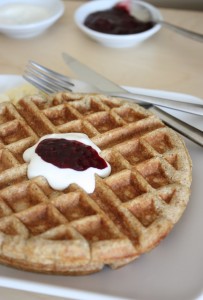 From Good to the Grain by Kim Boyce, reprinted with permission
From Good to the Grain by Kim Boyce, reprinted with permission
2 ounces (1/2 stick) unsalted butter, melted, for the waffle iron
Dry mix:
¼ cup amaranth flour
¼ cup flaxseed meal
1 cup whole-wheat flour
1 cup all-purpose flour
2 tbsp sugar
2 tsp baking powder
1 tsp baking soda
1 tsp kosher salt
Wet mix:
2 cups buttermilk
¼ cup plus 2 tbsp honey
2 eggs
2 tbsp unsalted butter, melted and cooled slightly
Finish:
Greek yogurt, optional
Turn the waffle iron to its highest setting. Even if you don’t usually heat it this high, these waffles come out best when cooked at high heat. Sift the dry ingredients into a large bowl, pouring back into the bowl any bits of grain or other ingredients that may remain in the sifter.
In a medium bowl, whisk together the wet ingredients until thoroughly combined. Using a spatula add the wet ingredients to the dry ingredients and gently combine. The batter will begin to bubble and swell as the baking soda begins to react with the buttermilk.
Brush the waffle iron generously with butter; this is the key to a crisp crust. Use a ladle or measuring cup to scoop ½ cup batter onto the spaces of the iron. Promptly close, and listen for the iron to sigh as the batter begins to cook. The smell wafting from the iron starts out like a freshly kneaded loaf of bread, then becomes toasty. Remove the waffle when the indicator light shows that it is done, or when a quick peek shows that it’s turned a dark golden-brown, 4 to 6 minutes. Remove the hot waffle with a fork, and repeat with the remaining batter.
The waffles are best eaten right off the griddle, with a bit of butter, a drizzle of honey, or a hearty spoonful of Greek yogurt, as desired.
P.S. The book says it makes 9 waffles, but I got 8.
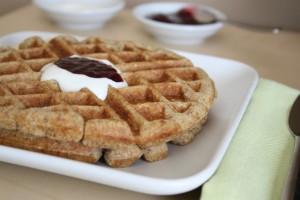
Disclosure: The review copy of this cookbook was sent to me free of charge. I was not under any obligation to write about it on my website and I did not receive any compensation for doing so.

